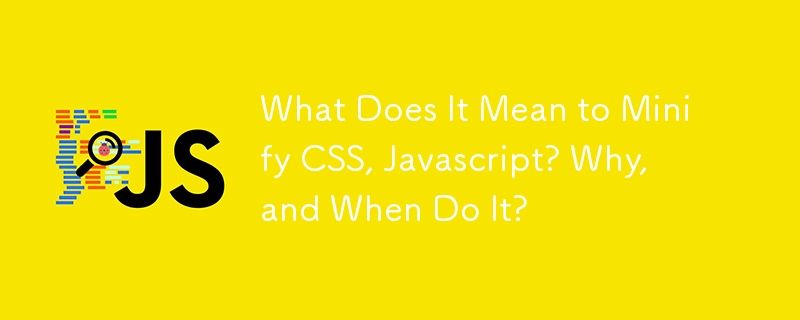縮小 CSS、Javascript 意味著什麼?為什麼以及何時做?
- WBOYWBOYWBOYWBOYWBOYWBOYWBOYWBOYWBOYWBOYWBOYWBOYWB原創
- 2024-08-14 17:23:01768瀏覽

最佳化網路效能對於提供快速、無縫的使用者體驗至關重要。實現這一目標的一種有效方法是縮小和組合 CSS、JavaScript 和 HTML 檔案。今天,我們將探討縮小和組合的含義、它們為何重要以及如何透過實際範例來實現它們
縮小化
縮小是從程式碼中刪除不必要的字元而不改變其功能的過程。這包括:
- 刪除空格:空格、製表符和換行符。
- 刪除註解:任何針對開發人員的非功能性文字。
- 縮短變數名稱:為變數和函數使用較短的名稱。
縮小範例
原始碼
CSS 檔案 (styles.css)
/* Main Styles */
body {
background-color: #f0f0f0; /* Light gray background */
font-family: Arial, sans-serif;
}
/* Header Styles */
header {
background-color: #333; /* Dark background for header */
color: #fff;
padding: 10px;
}
header h1 {
margin: 0;
}
JavaScript 檔案 (script.js)
// Function to change background color
function changeBackgroundColor(color) {
document.body.style.backgroundColor = color;
}
// Function to log message
function logMessage(message) {
console.log(message);
}
精簡程式碼
縮小 CSS (styles.min.css)
cssbody{background-color:#f0f0f0;font-family:Arial,sans-serif}header{background-color:#333;color:#fff;padding:10px}header h1{margin:0}
縮小版 JavaScript (script.min.js)
javascript
function changeBackgroundColor(a){document.body.style.backgroundColor=a}function logMessage(a){console.log(a)}
說明:
- CSS:刪除空格和註解。屬性名稱和值會盡可能縮短。
- JavaScript:註解和不必要的空格被刪除。變數名稱被縮短。
為什麼這樣做:
- 減少檔案大小:較小的檔案意味著下載的資料較少,從而縮短載入時間。
- 提高效能:更快的檔案傳輸可以加快頁面載入時間並提供更好的使用者體驗。
- 減少頻寬使用:較小的檔案可以減少傳輸的資料量,節省頻寬並可能降低成本。
何時進行:
- 部署之前:在部署到生產之前,作為建置過程的一部分縮小檔案。這確保了為用戶提供的程式碼的效能得到最佳化。
- 在每個版本中:將壓縮合併到持續整合/持續部署 (CI/CD) 管道中,以在每個版本中自動壓縮檔案。
合併文件
合併檔案是指將多個 CSS 或 JavaScript 檔案合併到一個檔案中。例如:
- 合併 CSS 檔案:您不需要將多個 CSS 檔案合併為一個。
- 合併 JavaScript 檔案:同樣,將多個 JavaScript 檔案合併為一個。
合併文件範例
原始文件
CSS 檔案
- 重置.css
- 排版.css
- 佈局.css
JavaScript 檔案
- utils.js
- main.js
- analytics.js
合併文件
組合 CSS (styles.css)
css/* Reset styles */
body, h1, h2, h3, p { margin: 0; padding: 0; }
/* Typography styles */
body { font-family: Arial, sans-serif; }
h1 { font-size: 2em; }
/* Layout styles */
.container { width: 100%; max-width: 1200px; margin: 0 auto; }
組合 JavaScript (scripts.js)
javascript// Utility functions
function changeBackgroundColor(color) { document.body.style.backgroundColor = color; }
function logMessage(message) { console.log(message); }
// Main application logic
function initApp() { console.log('App initialized'); }
window.onload = initApp;
// Analytics
function trackEvent(event) { console.log('Event tracked:', event); }
Explanation:
- CSS: Multiple CSS files are merged into a single file, preserving their order and combining styles.
- JavaScript: Multiple JavaScript files are merged into a single file, keeping functions and logic organized.
Why Do It:
- Reduce HTTP Requests: Each file requires a separate HTTP request. Combining files reduces the number of requests the browser needs to make, which can significantly improve load times.
- Improve Page Load Speed: Fewer HTTP requests mean less overhead and faster loading, as browsers can handle fewer connections and process fewer files.
- Simplify Management: Fewer files can simplify your file structure and make it easier to manage dependencies.
When To Do It:
- During the Build Process: Like minification, combining files should be part of your build process, usually handled by task runners or build tools (e.g., Webpack, Gulp, or Parcel).
- In Production: Combine files before deploying to production to ensure that users receive the optimized versions.
Tools and Techniques
- Minification Tools: Tools like UglifyJS, Terser (for JavaScript), and CSSNano (for CSS) are commonly used for minification.
- Build Tools: Task runners like Gulp or Webpack can automate both minification and file combining.
- CDNs: Many Content Delivery Networks (CDNs) offer built-in minification and combination features.
By minifying and combinSure! Let's walk through some practical examples of minifying and combining CSS and JavaScript files.
Why This Matters
- Minification: Reduces the size of individual files, which decreases the amount of data the browser needs to download.
- Combining: Reduces the number of HTTP requests, which decreases load time and improves performance.
Tools for Combining and Minifying:
- Gulp: A task runner that can automate minification and combining.
- Webpack: A module bundler that can combine and minify files as part of its build process.
- Online Tools: Websites like CSS Minifier and JSCompress can also be used for minification.
By following these practices, you optimize the performance of your web application, leading to a faster and smoother user experience.ing CSS and JavaScript files, you streamline the delivery of your web assets, leading to faster load times and a better overall user experience.
以上是縮小 CSS、Javascript 意味著什麼?為什麼以及何時做?的詳細內容。更多資訊請關注PHP中文網其他相關文章!

